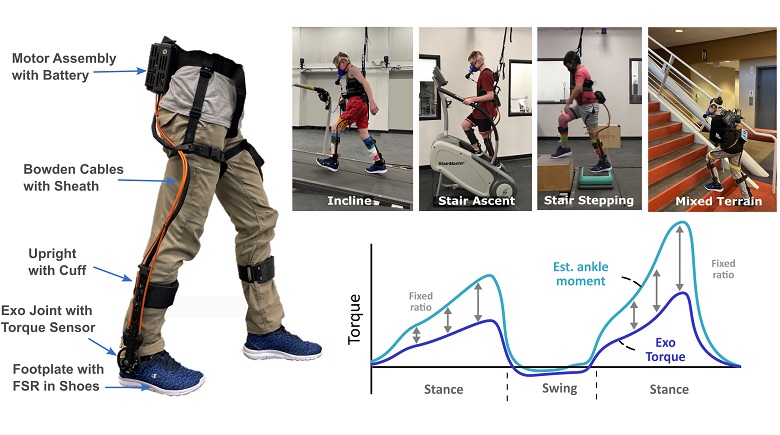
Navigating stairs and ramps pose as significant mobility challenges for individuals with movement disorders, including those with cerebral palsy (CP). Elevated energy cost during activities of daily living can lead to a less active lifestyle and lower quality of life for this patient population. This study aims to (a) clinically-validate the safety, accuracy, and efficacy of adaptive ankle exoskeleton assistance on graded terrain in CP and (b) investigate the biomechanical mechanisms underlying changes in ambulatory performance, to facilitate mobility in challenging free-living setting.
We tested a novel battery-powered ankle exoskeleton on seven ambulatory individuals with CP. The device provided adaptive ankle plantar-flexor assistance during stance phase during stance phase and dorsi-flexor assistance per user preference during swing phase. Each participant completed 6-minute walking on 5° incline and 5-minute stair ascent when wearing shoes and with bilateral plantar- and dorsi-flexor assistance, while we measured metabolic cost, muscle activity, and joint mechanics. We also evaluated walking performance while they walked in a 330-m indoor route that consists of level ground and stairs.
The exoskeleton’s adaptive controller accuracy was over 80% for both activities. Ankle assistance improved the energy cost of steady-state incline walking by 14% and stair ascent by 21% compared to walking without the device, and reduced the muscular demand for the soleus and vastus lateralis during both activities. All participants safely completed the real-world mixed-terrain route. This is the first study to demonstrate safety and performance benefits of ankle assistance on graded terrains in CP, and it encourages future studies to evaluate longer duration mixed-terrain walking in controlled settings, and eventually longer-term testing in uncontrolled free-living environments.
